Homemade soy milk is more nutritious, tastes better, and is eight times cheaper than the packaged product. {gluten-free, vegan}
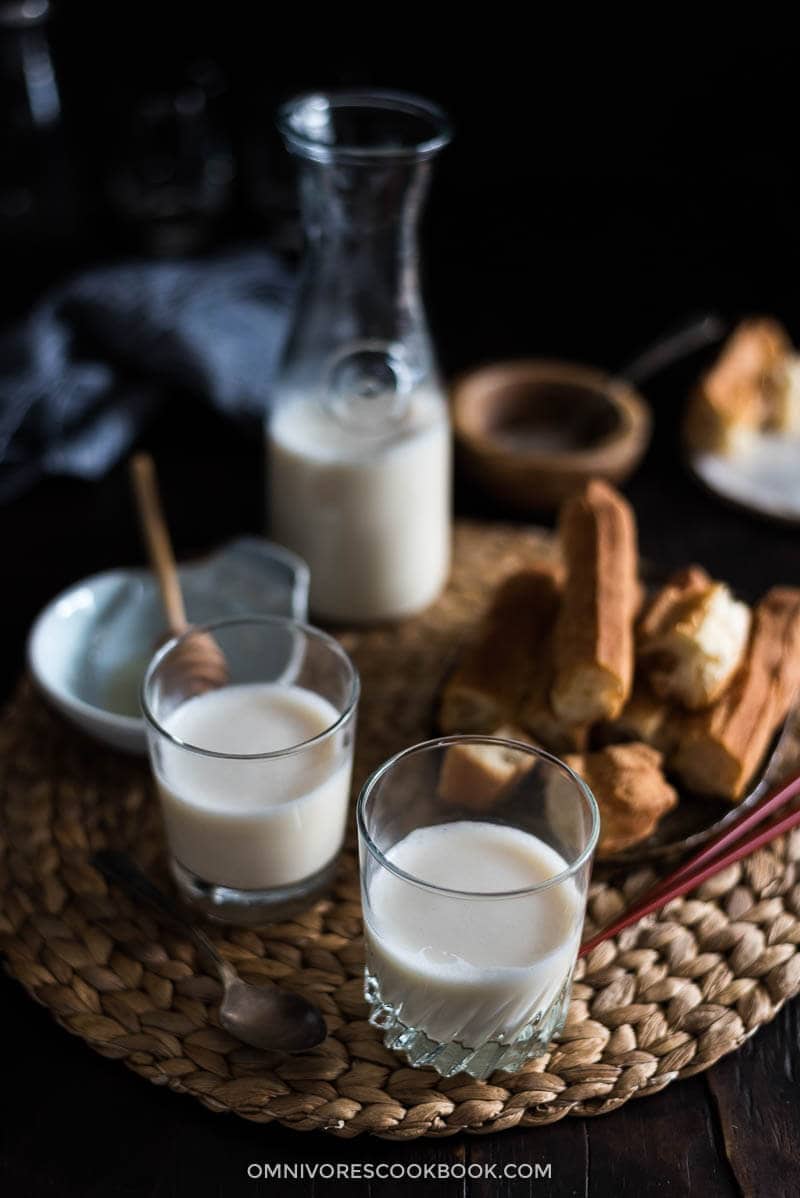
After moving from Beijing to the US, one of the things I’ve missed most has been the breakfast. The freshly made hot soy milk (豆浆) and the crispy, fluffy fried dough sticks (油条) are the best best combo to start a day happy. One of the most famous all-day breakfast chains – Yung Ho Dou Jiang Restaurant – has “soy milk” in its name. So you can imagine how important this morning staple is for Chinese people!
In my parent’s home, the soy milk maker sits right next to the rice cooker. My mom always used it 2 to 3 times a week to make fresh soy and multi-grain milk. Compared to the stuff you buy from the supermarket, homemade soy milk does not contain additives, and you can adjust the sweetness by using less sugar. The fresh and fragrant taste of homemade soy milk is something that manufactured versions cannot get anywhere near.
Why homemade soy milk?
Since I moved to the US, I started off just drinking boxed soy milk. One time I left an opened carton in the fridge and completely forgot about it. To my biggest surprise, it was not spoiled and still tasted fine after sitting in the fridge for more than a month…. when it really shouldn’t last more than a few days! That’s when I decided I needed to eliminate all plastic- and paper-packaged milk and start making my own.
Homemade soy milk has three major benefits:
- It does not contain additives, preservatives and chemical sweeteners
- You can choose to add less sugar, which translates to a lower calorie consumption
- The cost of homemade milk is $1 / gallon (or 4 liters), which is 8 times cheaper than the manufactured versions
Why use a soy milk maker?
Yes, you can always make soy milk without a soy milk machine – I used to do it before I purchased my soy milk maker. But if you enjoy drinking soy milk (or other plant-based milk) on a daily basis, the complicated cooking process might not be very practical.
The problems of using the traditional method to cook soy milk are:
- It requires using and cleaning up lots of equipment
- It requires an expensive, powerful blender, otherwise you end up with a lot of bean pulp and a watery milk
- You need to monitor the cooking process closely so the milk won’t spill and make a mess on your kitchen counter
- It requires removing the bean pulp before cooking the milk, which results in a less flavorful drink with less nutrients
In contrast, a soy milk maker provides solutions to all these problems and offers further benefits:
- You only need 3 minutes to set it up and then you can leave it
- The whole cooking and blending process is done in one machine. This creates less hassle and zero monitoring required
- You can even make soy milk from dry beans without needing to soak them
- Cleaning up is very easy and only takes 3 minutes
- You save 40 minutes active cooking and prepping time
- The soy milk tastes better and is more nutritious, because the bean pulp is cooked in with the milk
How do I use a soy milk maker?
I was so happy when I found Joyoung Soy Milk Maker on Amazon; it’s the same brand that my mom uses. Joyoung is a famous Chinese home appliance maker and owns the largest market share for its soy milk machine – so I made the purchase without a second thought.
The soy milk maker comes with two parts. A body that is plastic on the outside and stainless steel inside, and has a lid with a heating element and a blender attached. When you close the lid and plug in the cord, you’re basically done with setting up the machine.

There are a few other things that come with the package.
- A small bag of dried soybeans that’s enough for making one batch of soy milk
- A plastic cup for measuring the beans
- A plastic container and a fine stainless steel mesh to strain the milk
- A not-very-detailed manual (which is my only complaint)
Starting a batch of milk is very easy. You only need to:
- Soak the beans overnight (or not, if you prefer!)
- Add the beans into the soy milk maker and add water to the mark
- Start the machine by pushing one button
That’s it! It only takes like 3 minutes to set up and then you can forget about it.

Once the machine beeps again, you will have a pot of freshly made soy milk! Here we need to do one more step to make the milk more smooth – strain the milk through a fine mesh.
This process will remove most of the bean pulp, which you can save and use for cooking pancakes (see recipe below).
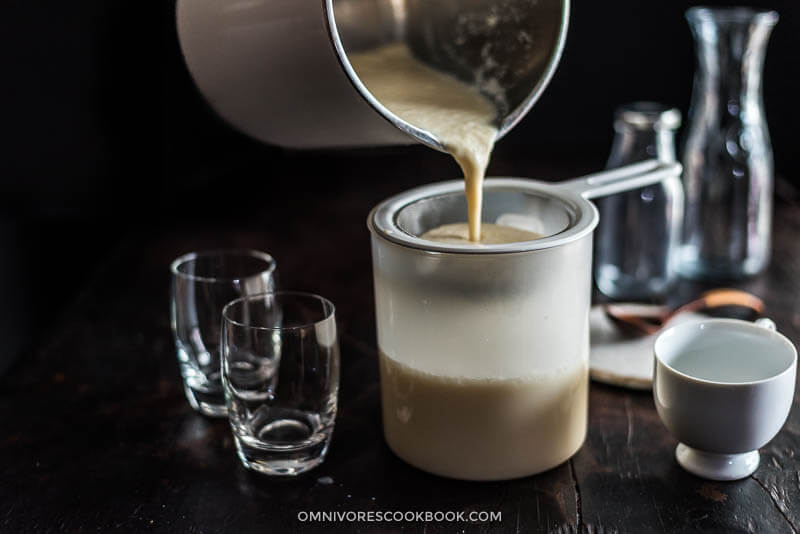
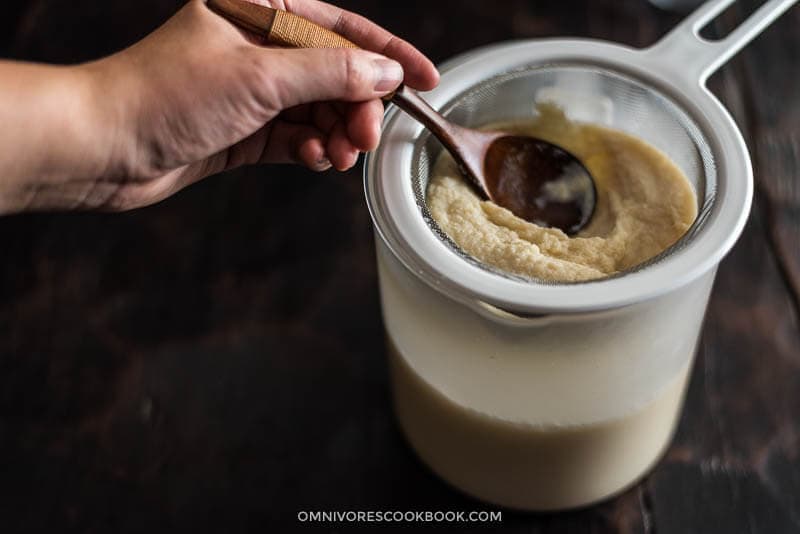

I enjoy my soy milk hot with a little syrup, the same way we do in China. But if you prefer your soy milk cold, you can always cool it off or add ice cubes. I like to store leftover soy milk in mason jars.
Once I finish making a batch of soy milk, I always to wash the machine immediately while it’s warm, so the bean pulp residue comes off easily. Alternatively, you can fill the machine with hot water and place the lid back on to soak it before you’re ready to wash.
What about the leftover bean pulp (okara)?
Most recipes will tell you to throw it away, which is a massive waste. The bean pulp, or kara in Japanese, contains high dietary fiber and calcium and is abundant in protein, carbohydrates and potassium (according to the Japanese Tofu Association).
This bean pulp has a coarse texture that isn’t particularly pleasant if you eat it directly, so you’ll want to use it with other ingredients to alter the texture. My favorite method is to mix the pulp with egg and flour to make green onion pancakes. It takes 10 minutes to whip this together and then you have a full breakfast!
You can see the full okara pancake recipe right next to the homemade soy milk recipe below.
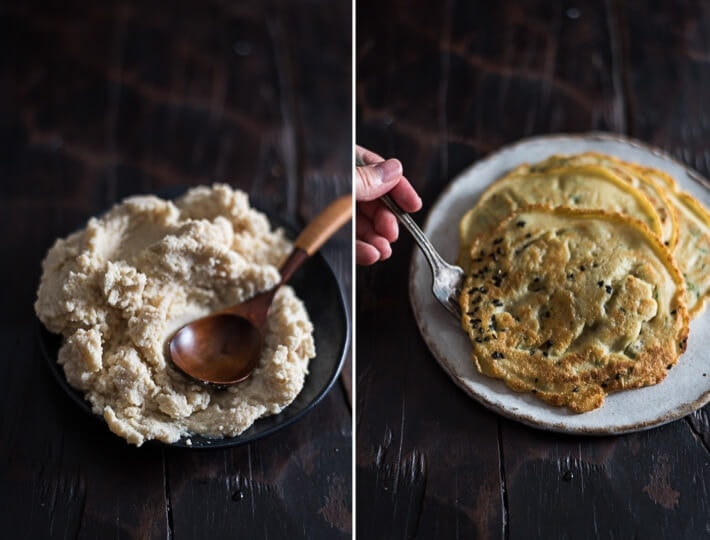
For more vegan recipes using okara, check out this website: okaraproject.blogspot.com
Since I got my soy milk maker, I’ve been making plant-based milk 2 to 3 times a week because it’s unbelievably easy! Homemade soy milk is a great snack that I drink in the morning, with dinner, or during the day. I like the fact that it keeps my stomach satisfied and my body hydrated.
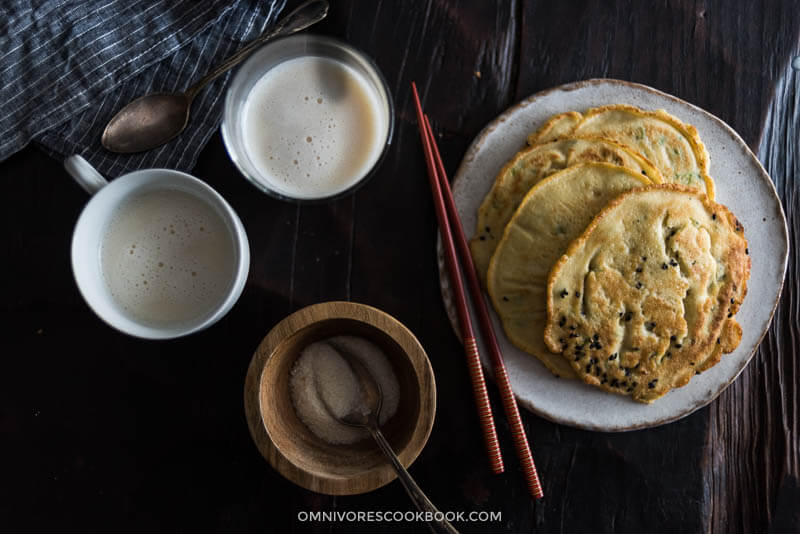
What is your favorite plant based milk? Leave a comment below to share your thoughts!
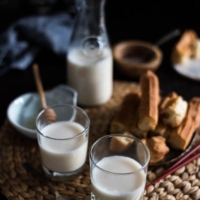
Homemade Soy Milk (with Soy Milk Maker, 豆浆)
Ingredients
- 1 and 1/2 cups (120 grams / 4.2 ounces) dried soy beans (by using the cup comes with the machine)
- 7 cups filtered water
- Agave syrup or maple syrup (Optional)
Instructions
- Use the soy bean cup that comes with the machine to measure 1 and 1/2 cup dried soy beans. Add into a bowl. Rinse with tap water for 1 to 2 times to remove dust on the surface and drain. Add water to cover the beans at least 1-inch deep.
- (Cook with soaked beans) Soak the beans overnight or for at least 6 hours.
- (Cook with dry beans) Skip the soaking process above and start making the soy milk immediately after rinsing. (*Footnote 1)
- Drain the soaked soy beans and add to the soy milk maker. Add filtered water until it reaches the 1700ml mark.
- Place the lid of the soy maker on and adjust so it’s firmly attached. When you plug in the cord, you should hear a beep and the soy maker shows “Keep Warm” on the lid. This means you’ve set up the machine properly. Choose “soaked beans” and you will hear two beeps. This means the machine has started. Soon after you start the machine, you will hear a loud noise for a few seconds, which means the machine has started to grind the beans while heating up.
- Now your job is done and you can relax. A big jar of freshly made soy milk will be ready in 30 minutes. During that time, you will hear the machine mixing from time to time; the noise is about same level as your blender.
- Once the soy milk is done, the machine will beep for 1 minute and automatically switch to “keep warm” for an hour. Please note, you should not leave the hot soy milk in the machine for more than 4 hours.
- Place the fine mesh over the jar that comes with the machine (*Footnote 2). Pour the soy milk into the jar to remove the soy pulp. You can use a small spoon to stir and press the soy pulp, so it speeds up the process and lets the milk drain thoroughly.
- Now the soy milk is ready to drink. You can enjoy it hot or cold. My favorite sweetener is agave nectar or maple syrup. If you feel the bean flavor is too strong, adding one to two drops of vanilla extract will even it out a bit.
- To store the milk, let it cool to room temperature, then transfer to airtight jars. Store in the fridge for 3 to 4 days.
Notes
- The soy milk made with dry beans tastes almost as good as with soaked beans. However it generates a very fine bean pulp that is difficult to remove using the fine mesh, so the milk is not as smooth as a result. You can strain the milk first and let sit for a while. The bean pulp will sink to the bottom; then you can pour the milk into glass without pouring the bean pulp.
- The jar is plastic. I always let the the soy milk cool down for a bit before draining. If you do not like pouring hot liquids into a plastic jar, you can use a ceramic bowl instead.
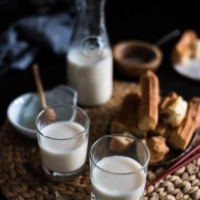
Green Onion Okara Pancakes (Pancakes made with soybean pulps)
Ingredients
- 1/4 cup soy bean pulps (okara)
- 1/2 cup flour
- 1 large egg
- 2 green onions , chopped
- 1/4 teaspoon salt
- 1/8 teaspoons white pepper
- 2 to 3 tablespoons peanut oil (or vegetable oil)
- Black sesame for garnish (Optional)
Instructions
- Whisk everything in a big bowl until it just form a runny smooth paste. Do not mix too fast or over mix, which develops gluten and will yield tough pancakes.
- Heat a nonstick pan with 2 teaspoons oil until hot. Add 1/4 cup pancake mixture and gently shake the pan to form a round pancake. Cook until the bottom set, 30 seconds to 1 minute. You can add a small pinch of black sesame onto the pancake, if using. Flip to cook the other side until the pancake just set, for another 30 seconds. Transfer to a plate and cook the rest pancakes by using the same method.
- Serve hot as breakfast.

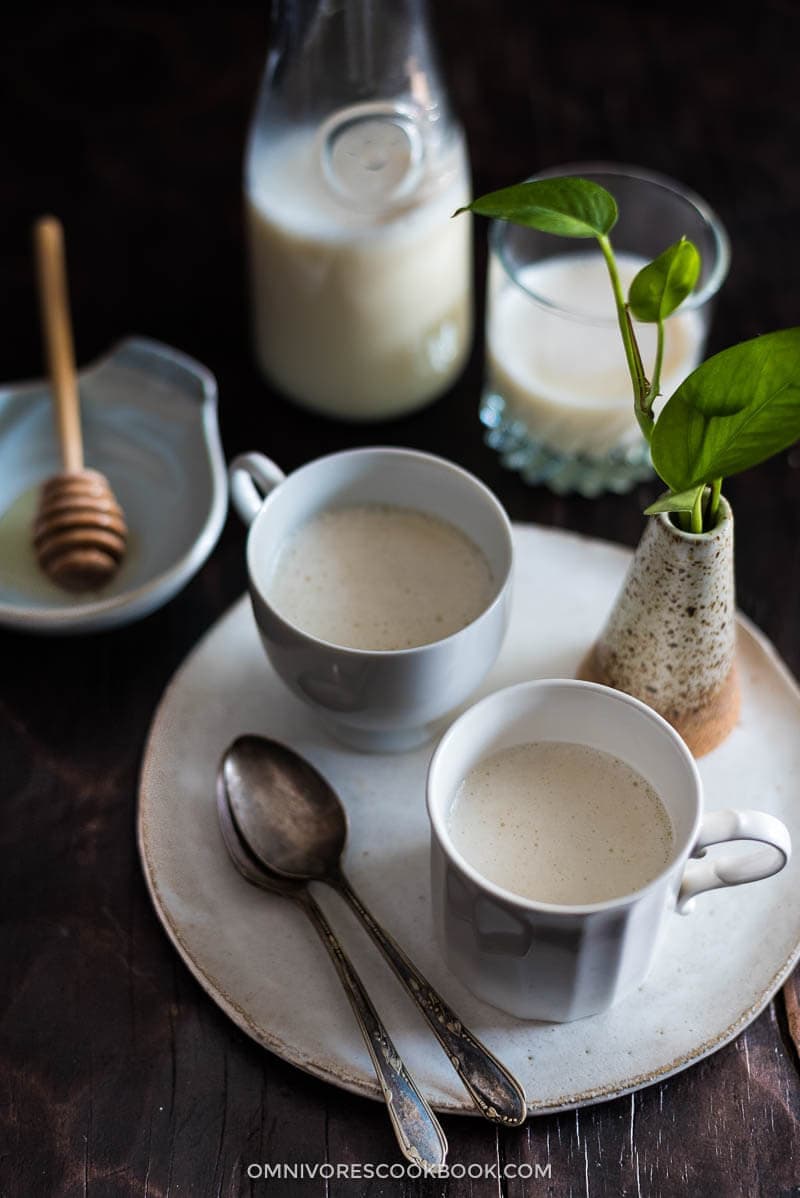
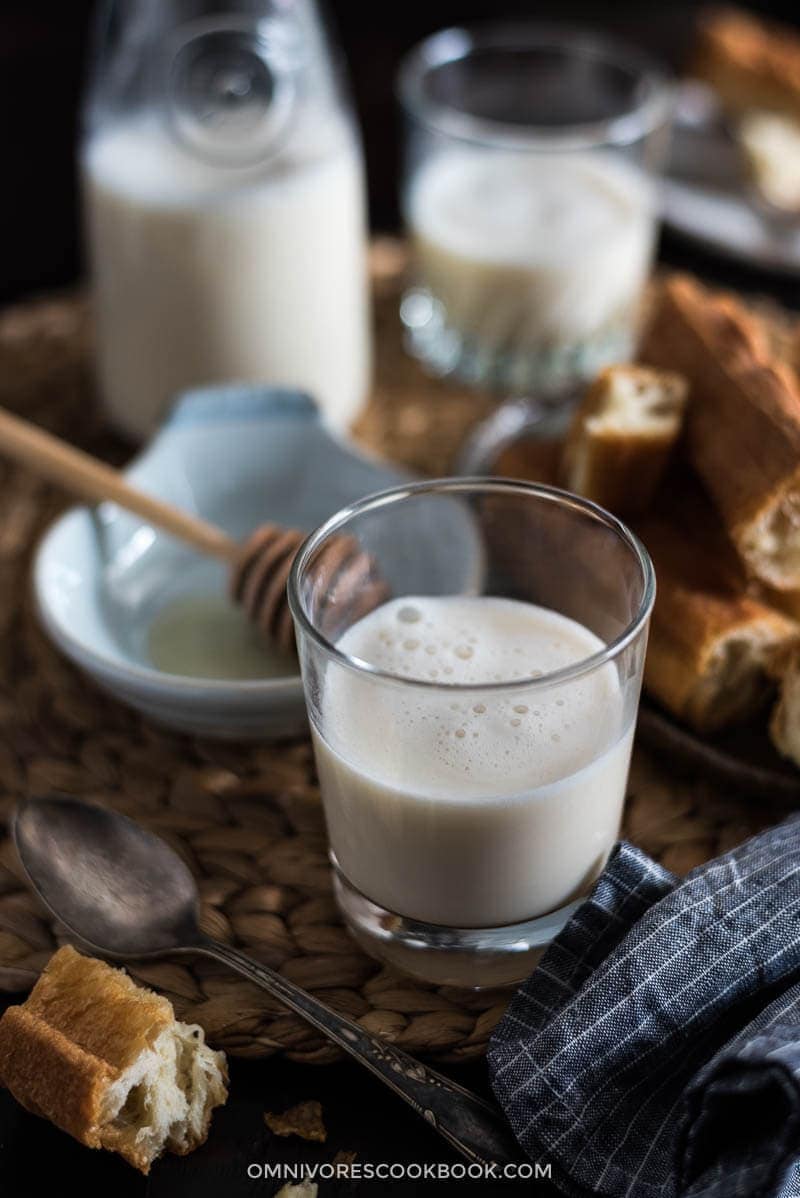













NICE!! I would typically file soy milk under “things I buy” versus “things I make”. Thanks for shifting my thought on that – this looks amazing!
I am SO impressed! You recycled the kara and made it into scallion pancakes that is more healthy for you! Thank you so much for this recipe and introducing the soy milk maker. I will consider buying one, because I would love to make my own soy milk for the very reasons you explained. I found an asian market that sells dried soybeans the other day.
Hi Pey-Lih, I’m glad to hear you’re interested in the recipe and trying out the machine. My family really love soy milk so I’ve been making many times a week. If you drink it frequently, it’s definitely a great investment. Plus, you can make tofu at home as well!
I have this soy milk maker. I purchased it to make home made tofu but I have been so unsuccessful for over a year now. I really need help on how to use the soy milk from this Joyoung to make tofu. Can you help?
Hey Cal, when I make tofu I generally use 500g of dried soy bean (a few batches in the maker) and strain the milk into a large pot as I go. Usually the milk will still be hot when I add the nigari or calcium carbonate but if not I will heat it a bit on the stove prior to adding. I use 2 tbsp of nagari powder to coagulate the milk. The nagari is dissolved into 1/4 or 1/2 cup of water and added in the following manner to the pot of milk. Stir the milk rapidly with a spoon then add half of your nagari. Use your spoon to stop the milk swirling just as you add your first half nagari. Wait about a minute then gently swirly your spoon through the milk whilst adding the rest of your nagai – you don’t want to go mental at this point as you are hoping that soy curds are forming and you don’t want to be destroying them. Wait a few more minutes then use a slotted spoon to remove the curds into a press lined with a couple of layers of cheese cloth and press for about 15 – 30 minutes. This amount makes about 2 shop sized blocks of tofu usually.
one thing I couldn’t figure out is how to get rid of those “Beany taste” in homemade soy milk (not via machine). it’s kind of bitter taste left in your throat after drink down.
I soaked them 24 hours and took off bean skins and washed and raised multiple times—didn’t help. I blend them after soaking and cook about 30 min. and sequeeze the milk out.
What is the Chinese old folk way to make tasty milk without those unpleasant taste? I don’t like machine as it doesn’t really taste like milky because it’s not coming out from pressure.
thanks
Hi Linda, hmmm, I’ve never really had the bitter taste when drinking the homemade soy milk. It is quite a bit beany, but it is not in a pleasant way. Nowadays I mostly cook directly from dry beans.
I’ve seen other recipes (without machine) indicate that you should press the milk first before cooking it. Have you tried it?
Some readers mentioned that adding a bit cinnamon and nutmeg will be helpful to eliminate the beany taste. And always sweeten your milk, even just for a bit. It will be helpful too.
you want to cook in boiling water for about 5 minutes to deactivate the enzyme that is responsible for the beany taste. If you blend/damage the bean prior to deactivating the enzyme then you will get the nasty taste.
This post is extremely helpful. I just received the Joyoung soy milk maker today. The instructions do not translate well to English. This clarifies many things for me. Thank you. Of course, now I am curious about rice paste. What do you do with rice paste?
Hi Laura, I’m glad to hear you found my post helpful! The rice paste is more like a blended congee, which we sweeten with sugar and serve as a snack. I know it does not sound so appetizing, but it tastes way better than it looks. The translation is a bit off. I think it’s closer to “rice smoothie” or “rice soup”. The one I like the most is the black sesame, which was a snack I ate growing up. If you’re curious, check out this recipe: https://omnivorescookbook.com/recipes/breakfast-smoothie-with-walnut-peanut-and-rice It is a very close thing to the “rice paste”, with a rich nutty flavor when you add the nuts. I made it a long time ago before I purchased the soy milk machine.
amazing!!! This can replace fresh cow milk’s existence
Hello,
I just bought the Joyoung soy milk maker and made my first batch of soy milk last night using your instructions. Thank you for your helpful page! I made the pancakes this morning, but using the recipe, my batter was extremely dry and crumbly. I wonder if my okara wasn’t as liquidy? My fiance really went to town trying to filter every last drop of milk out of it haha! Although not listed on the ingredients, did you add soy milk or water to the recipe? I ended up adding 1/4 cup soy milk and 1/4 cup apple sauce to make the flour:liquid ratio closer to 1:1. They turned out pretty good but still thick. Any suggestions? I enjoyed them with soy sauce, and my fiance used ginger syrup.
Thanks, and I look forward to exploring your page more!
Ashley
Hi Ashley, I’m glad to hear the post was helpful! As for the okara pancakes, I do remember they are on the drier side. I needed to use a bit more oil to obtain the crispy texture. Yes I did add soy milk to the pancake batter. So sorry I forgot to mention it in the recipe! The amount depends on the dryness of the okara, but at the end, you should add enough liquid to make a rather runny batter.
I just got one of these machines and was wondering if you have or can make other plant based milks in it? My husband is allergic to soy.
Hi Jane, yes, you can totally make other types of plant-based milk and the method stays the same.
Thanks for the Tong Yau Bing Recipe I have been making soymilk for many years as my wife loves it She is from Shanghai and also likes tong yau bing for which I use a different recipe but I will try your recipe for breakfast tomorrow ( I usually compost the okara)
OMG! I just made my first batch of soy milk using my SoyaJoyG4 soy milk maker and made the Okara pancakes afterwards. Delicious! My rather picky husband LOVES the Okara pancakes. The soy milk tastes so much lighter than the store-bought brand. So very easy and totally worth the overnight soak. I actually enjoyed the hot soy milk as well, which normally I avoided in the past. I can’t wait to make other kinds of nutmilks 😍😘💖💘
I have a Joyoung soy milk maker too but the capacity is not as big. Mine has a capacity of 1300 ml. Do you think that the little measuring cup that comes with the soy milk maker is smaller than Yours? Should I still measure 1.5 cups of beans?
I’ve been weighing 90g on my scale but am tired of pulling it out Everytime I make soy milk!
Thanks
i am just about 2 minutes away from buying a soya maker because of your great video.
i like choc.soya milk. what would i add ? powder or syrup and where and when?
thanks
I have been making soymilk with dried beans soaked overnight and then if I’m making tofu I grind beans in the blenderthen strain out the okara that I then have to cook the okara before eating the okara and I have to cook the soymilk separate and then add the coagulant and make tofu. If I make the soymilk to drink I soak beans overnight, then drain then cook for 20 minutes, then drain, then I grind in blender with spring water and strain. I tried a couple times to make tofu with the milk after I had cooked beans together for soymilk but it wouldn’t coagulate properly so I am wondering if I buy the machine, the Joyoung Soy Milk Maker to make soymilk will I be able to use that soymilk to make my tofu? Thank you for your time reading this and thank you for the wonderful pancake recipe I will have to try that!
Hi Maggie, thanks so much for sharing your process. I used to experiment with making tofu with the soy milk from my Soy Milk Maker, but it never coagulates properly. I thought it’s probably because my soy bean to water ratio is off, since most of the tofu recipes call for a different ratio. Now hearing your process, I think it’s might be the way that the soy milk is cooked does not work for tofu making. The Soy Milk Maker uses the second approach you mentioned – it cookes the bean and milk together while grinding them. I don’t think it’s a good idea to purchase it for tofu making. At least I never succeeded.
Hi, I see in your post that I’ll still need to strain away the okara myself even with this machine, but some soy milk makers appear to also do the straining based on what people say in reviews…? Should I expect to do this straining step with all soy milk makers? Thanks so much for this post!
I don’t have one of the fancier version so I’m not 100% sure. But based on what I’ve read, the no-straining machine simply blend the soy beans very fine so you can drink the milk directly. I think some people like it but some people find it still taste too beany. It’s hard to tell until you try it out.
Hi, I know this thread is a couple of years old, but I’m hoping you can help me with several points.
I was very excited to receive my joyoung soy milk maker yesterday. It’s one of the more expensive models which supposedly grinds finely.
I made my first batch last night and didn’t strain it.
I didn’t presoak the beans. The milk was delicious hot, but this morning the sludge had settled, I shook it up but it was still grainy in texture.
My machine has a 22 minute cycle and a 50 minute cycle for soymilk. I used the longer one, any advice on which is better? The book is very basic and not much help!
I’m wondering if anyone can help with how to stop it from curdling when making coffee with an espresso machine?
Thanks in advance!
Hi Dorothy, do you have a link to the product so I can check out the model?
I’ve never used one of the fancier version before so it’s hard for me to provide a good answer.
I wonder if you used more soy beans than suggested? Have you tried heating up the soy milk the next day and see if you can resolve the issue?
When making soy sauce using the traditional method, the residual (okara) is always strained and separated due to their gritty texture. Maybe the cold soy sauce amplify the okara so it tastes less nice than the hot one.
Also, most traditional soy milk need 20 mins or so to cook so I’m not sure if the 50 minutes would make any difference.
I think the best way is to contact Joyoung (or leave a question on the website you purchased it).
I’m looking at upgrading my soy milk maker too and this is very useful information. But until I got one and tried it out my hands are tied.
Hi Maggie, thanks for your quick response.
I bought it on eBay from a local Asian kitchen supplier.
https://www.ebay.com.au/itm/363030838637
I made a second batch yesterday. It’s much nicer, but I still have the problem with it separating the moment the frothed milk hits the espresso coffee, and then goes really thick even after stirring.
This time I presoaked the beans for about 8 hours and used the 22 minute cycle. I then strained it and added a pinch of salt while still hot. The result was smoother and very creamy. I read somewhere that you get a creamier texture if you presoak.
I made the pancakes this morning, very nice!
It seems to not be a very common model, JOYOUNG DJ13S-P90
I’ll need more help on using it for its other functions, but apart from the coffee problem, I’m now happy with the soy milk results.
Ooohh, that is a great one! I’ve been looking at the same model as well and was thinking about getting it.
I’m glad to hear that your second try turned out better.
So I’ve had problem with plant-based milk curdling when I add it to my coffee or tea sometimes, using the store-bought one.
I did a bit research and found out that the reason is the plant milk reacting with the acid in the coffee. The acid acts as a coagulant and turned the soy milk into tofu curd. I read the best way to avoid it is to add some coffee to the soy milk to slowly heat it up, then add the soy milk to the coffee (I know it sounds weird!). The other way is to use less acid coffee.
I think the soy maker can make other grain milk too. My mom likes to make black soy milk (by adding sesame seeds I remember) and sometimes multigrain milk. Let me know if you need further help!
Hi Maggie,
I wrote a detailed reply to your response to my first post.
It’s not showing up now. Has it got lost or is it waiting for you to approve it?
Thanks,
Dorothy
Just approved!
Hi Maggie, still no luck with the coffee. I added a couple of tablespoons of coffee to the soy milk before frothing the milk. Maybe not enough.
I’ve just read a couple of suggestions which I’ll try over the next couple of days.
One is to add the coffee to the milk, not the other way around as is traditional with espresso.
If that doesn’t work, the other suggestion is to add a tiny pinch of bicarbonate soda to the coffee before adding the milk. I’ll let you know how I go.
Cheers, Dorothy
Hi Maggie, just to update you again!
This morning I tried adding a tiny pinch of bicarbonate soda to the espresso coffee, then frothed the soymilk, poured it into the espresso, and it worked!! Hooray!
Hope this helps you and others 🙂
I’m glad to hear it worked out eventually! I can’t wait to buy the new soy maker and try it out myself 🙂
Hope you’re not sick of my updates!?!
Today I had the best result yet.
I made what in Italy is called a ‘latte macchiato’
Frothed the soy milk first, poured it into the cups, then expressed the coffee adding a pinch of bicarbonate of soda, then poured that into the cups, which leaves the stain (macchiato) on the top.
In the soy recipe I only added a pinch of salt, no sweetening which I’d been doing in my efforts to prevent curdling.
Good luck with your new soymilk maker!
I’m looking forward to sharing experiences and recipes with you.
Dorothy
BTW, I don’t get notifications of responses, so I’ve been keeping the tab open and checking back every now and then
Hi Dorothy, no worries at all! Always happy to discuss and I’m glad to hear you finally got the result you wanted.
I wonder why you don’t add any sweetener? I think it’s OK to add some sugar or syrup since it should not affect curdling.
I think pour the coffee into the milk might be the way to go. I’ve read it online too and it’s good to hear it’s working 🙂
Hi Maggie, just to answer your question about sweetening the soy milk….my husband is type 1 diabetic, also we both prefer the flavour of the milk unsweetened.
Cheers, Dorothy
Hi, Do you know if the % of the milk is 11%, like the Banrai milk and if we can make soft tofu with it ?
Unfortunately you don’t. I’ve tried using the soy milk from this method to make tofu and failed many times. It’s very hard to nail down the correct ratio.
For tofu making, I would not use a soy milk maker and instead use the traditional method: https://omnivorescookbook.com/how-to-make-soy-milk/
You will get a much thicker milk this way and it’s more suitable for soft tofu making.
I’ll look into this and hopefully post a recipe about it in the near future.
Been making soymilk using your recipe for a while but would like to try a multi grain milk, using rice, oats other grains. Any tips on amounts of differing grains you or your mom used? Is the cups to water ratio the same in your soymilk maker as soy beans? Any tips would be appreciated. Ps.love your recipes.
Thank you for sharing your great information. I read your blog daily . It give me so much knowledge and ideas.
I lost my instruction maual! Any chance you could please please please email me recipe to make oatmilk in my soymilk maker? And, I’m so glad it was easy to find you by googling!!! Thanks!
Hi, can you use this soy milk to make tofu fa?
The okara pancakes turned out delicious!! Thank you so much for sharing! I added some milk and water to get pancake batter consistency and then poured the whole thing into a frying pan – quick and easy!
I never thought about making my own soy milk I’m going to order the recommended maker and give it a go!
I just received my Joyoung soy milk maker. Yes, the instruction manual and recipe book are not very helpful. Thanks so much for the further information. Do you know if the milk maker simmers the soy beans to neutralize the enzymes, or should I add this to the process?
Can you tell me the process for making Congee in the milk maker? What are the measurements ? Which buttons should be selected?
Also, same for oat milk— measurements? Process?
The soy milk maker will simmer the soy beans during the process, so you don’t need to add this step to the process.
I haven’t tried making congee yet because my old soy milk maker doesn’t have the function. Which soy milk maker you’re using?
For oak milk, I didn’t create a recipe because heating up is not needed. You can blend the oats with water and strain them, which takes much less time than running it through the soy milk maker.
Both the soy milk and pancakes are great recipes. No waste! Thanks.